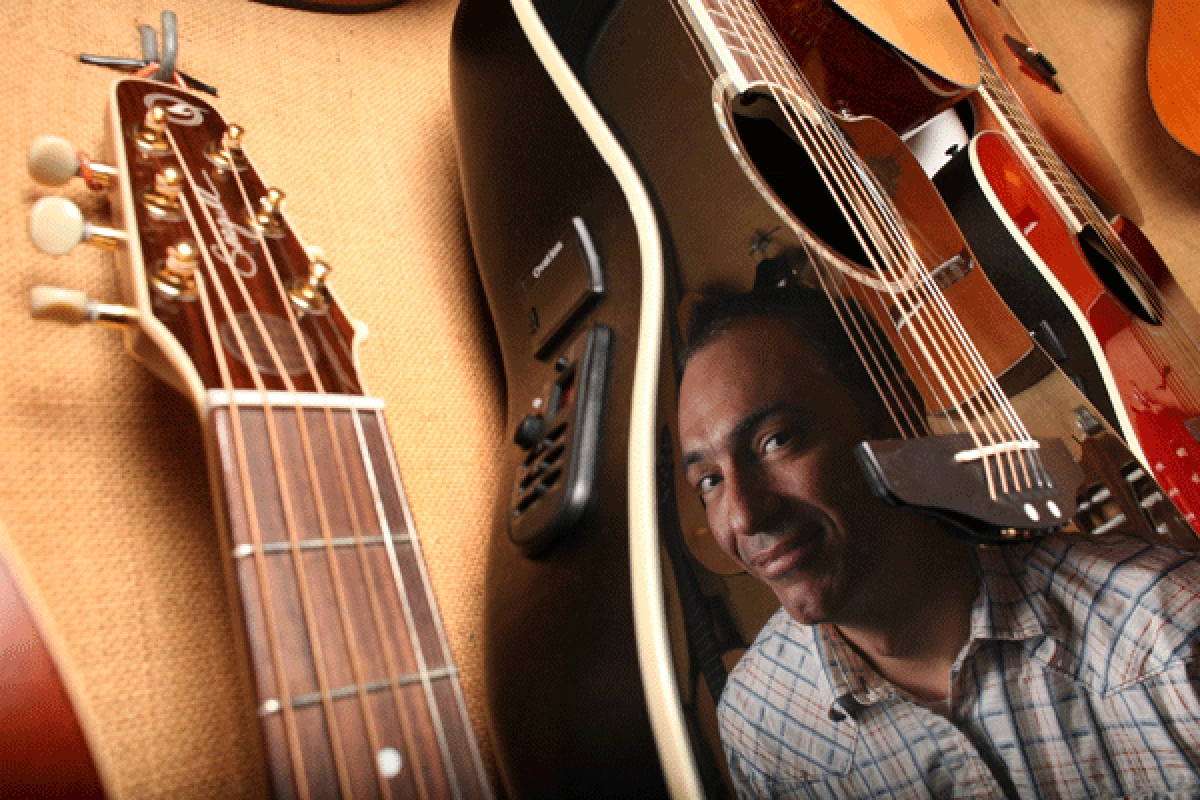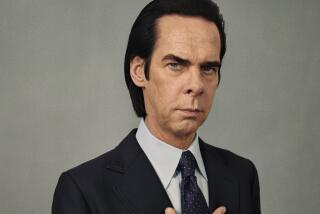The ballad of a classic guitar shop

Most Southland music fans know McCabe’s Guitar Shop for the innumerable folk, country, blues, jazz and world-music concerts presented over the decades in the tiny back stockroom that can hold about 150 folding chairs when all the instrument cases are shoved out of the way.
But in 1958, Gerald McCabe opened the doors on Pico Boulevard in Santa Monica intending to focus on furniture design and restoration. His timing coincided with a booming interest in folk music that spurred millions of Americans to buy acoustic guitars, banjos, mandolins and other non-amplified musical instruments.
Someone brought in a damaged guitar one day and asked if McCabe could fix it -- it was made of wood, after all. McCabe and partner Walter Camp soon began repairing instruments and offering new ones for sale, and the little shop quickly became a hub for musicians living in or passing through Los Angeles, many of whom would perform in the intimate space after hours.
“Walter figured that if you’re paying rent on a place 24 hours a day, why close the doors at 5?” said Robert Kimmel, a former member of Linda Ronstadt’s Stone Poneys band who was hired in 1969 as McCabe’s first official concert director. “He was giving music lessons at night and then started doing concerts on the weekends.”
McCabe’s is now a Southern California institution. It’s been a home to touring musicians and a supportive launchpad for aspiring local ones. It’s frequently been more than just a stage, serving as a catalyst for a song, an album, a band, a friendship.
Loudon Wainwright III recorded a live album there, John Hiatt’s 1987 breakthrough album, “Bring the Family,” grew out of his association with McCabe’s, the Ditty Bops practically grew up there and Richard Thompson played his first U.S. solo show there thanks to concert director Nancy Covey, to whom he’s now been married for 25 years.
On Thursday, Thompson will participate in a tribute to the music venue scheduled to take place at UCLA’s Royce Hall. The lineup includes Jackson Browne, Odetta, David Lindley, Jennifer Warnes, Bonnie “ Prince” Billy, the Savoy-Doucet Cajun Band, Peter Rowan, Peter Case and the Ditty Bops.
To mark the occasion, Calendar invited several performers to share their stories of the musical community that has grown up at McCabe’s.
Dave Alvin (singer-songwriter)
The weird thing about McCabe’s is I’d never really felt comfortable there. The whole vibe is comfort, and you talk to all these artists who say it’s so relaxed. Maybe that was true for others, but if you’ve got a loud band and you’re playing in a sweaty club where people get drunk, that’s where I’m comfortable.
I did a Monsters of Folk show there [in 1998] with Ramblin’ Jack Elliott, Chris Smither and Tom Russell, and that one was pretty emotional for me. It was part of a tour where we did the whole country in two weeks. When we got to McCabe’s and did that show, with the four of us there on stage, it was a defining moment for me. . . . At gigs before that one, I always felt that if they had nothing better to do, they’d let me play. After that, I kinda felt like I belonged there.
John Chelew (concert director, 1984-1996)
It’s been such a great meeting place for so many different people. Arlo Guthrie was getting ready to go on stage one time, and Allen Ginsberg was there because we had him booked the next night. He said, ‘Let me talk to Arlo; I haven’t seen him in 20 years.’ And they had this wonderful discussion. Sometime later, Arlo was playing the new Ash Grove on the Santa Monica Pier, and he started fingerpicking one of those “motorcycle blues” kinds of storytelling songs, and he starts talking about seeing Ginsberg after 20 years at McCabe’s.
It was a great example of how this place has a way of reminding people of some of their strengths, or renewing connections they may have lost, and the way that music reminds us of who we are and who we can be.
Nancy Covey (concert director, 1975-1984)
I had booked [accordionist] Flaco Jimenez to play, and then I get a phone call one day from this guy who gave me his name and said “We hear that you have Flaco Jimenez coming. We want to open, and we’ll play for free.” That sounded pretty good to me. I thought, “OK, how bad could they be?”. . . . He said, “We’re called Los Lobos del Este de Los Angeles.”
They were getting known by then in East L.A., but they definitely were not known on the Westside. They became friends, and I invited them to our wedding. . . . Through them Richard played on their record. There was a connection there.
John Hiatt (on the genesis of “Bring the Family”):
I’d played there since the early ‘80s or maybe even the late-’70s, and I’d sort of built up a little bit of a following. After John Chelew had taken over the bookings from Nancy, we became friends. One time between shows we started talking about making some kind of record. He threw out this idea, “Wouldn’t it be cool to go into a studio in Santa Monica for a couple of days and do something with Ry Cooder and [drummer] Jim Keltner?” I said, “That’d be great. If you could get them together, I’d do it in a heartbeat.”
He said “Who do you want on bass?” I told him Nick Lowe was my favorite bass player, so he said, “You get Nick and I’ll work on the other guys.” I went home to Nashville, and a few days later he called and said, “They’ll do it.” I said, “You’re kidding?” At that point I called Nick and said, “This guy John Chelew has Ry Cooder and Jim Keltner ready to go into a studio -- would you be interested?” He said, “I’ll be on the next flight.”
I’d been dropped by Geffen Records. I’d already been confused because I didn’t know what the hell kind of record they wanted me to make. And when they dropped me I was even more confused. I’d gotten a call from Andrew Lauder at Demon Records [in England]. He’d heard I was dropped by Geffen and wanted me to make a record for Demon. I said, “Andrew, I don’t know what kind of record to make.” He said, “You can sing in the shower and we’ll put it out.”
Subsequent to that I had the conversation with John Chelew. My manager, Ken Levitan, who was my attorney at the time, arranged the distribution deal in the U.S. with A&M Records, and all of a sudden I had a label in America -- and a band and a new record. And it was all because of McCabe’s and John Chelew -- and Nick and Ry and Jim.
Robert Kimmel (concert director 1969-1975)
I remember J.D. [Souther] playing with Glenn Frey in [their band] Longbranch Pennywhistle. In the early days I discovered a lot of the really talented L.A. musicians who played there through other L.A. musicians. Longbranch was an example of that. Somebody told me about them and said, “You haven’t heard of those guys?” The next thing I knew they both had their own record deals.
Mort Sahl (humorist-satirist-political commentator)
In 55 years, I’ve worked everywhere. I’ve been there [at McCabe’s] probably a dozen times. This joint, in the Jewish word, has mashuma, it’s soul. . . . It’s the most soulful place I’ve been since the hungry i [in San Francisco]. . . . The thing you can do there, and it’s not really popular among the comedians, is not to provide escape but to confront people with the facts, and when you do that, it comes out funnier. The audience contributes a lot in that club. You [as a performer] might think of yourself as a flower, but you need rain. And the audience always provides it.
Ann Savoy (musician and Cajun culture historian)
Because we met Nancy Covey there, that led us to have the crawfish boil at our house every year and led us to produce [New Orleans Jazz & Heritage Festival] tours. Suzi Civita from Warner Music would come to McCabe’s, and through that I wound up being in “The Divine Secrets of the Ya-Ya Sisterhood” and met T Bone Burnett [music producer for that 2002 film]. All kinds of amazing things have happened from initial contacts we made at McCabe’s.
Richard Thompson (singer-songwriter)
The first time I went there was also the first time I played there, probably in ’82. I think it was the first time I’d played in the U.S. in about 10 years and the first time I’d ever played [solo].
My vivid memory of that first show is that I was so jet-lagged, I remember playing in my sleep. I kept telling myself to not close my eyes, which is something I do all the time anyway. But this time, I knew as soon as I closed my eyes I’d be gone. I then realized that I’d just played three songs, and I don’t remember anything about them.
Loudon Wainwright III: (singer-songwriter)
I’ve been playing there for over 30 years. Takoma Records used to be down the street, and they ran a line over to McCabe’s and recorded part of the [1978 “A Live One”] live album there. I think they served Champagne that night. It was the first time the club ever bent its rules about no alcohol.
Speaking of alcohol, I remember seeing this amazing Townes Van Zandt-Guy Clark show. It was really something to behold in that room where the main libation is herbal tea with a shot of honey in it. They were so incredibly, gloriously drunk . . . . They were just plastered. It was kind of a beautiful thing to behold. The audience too, it was like a contact drunk, like everybody in the room got drunk with them. That room is a conduit in so many different ways.
More to Read
The biggest entertainment stories
Get our big stories about Hollywood, film, television, music, arts, culture and more right in your inbox as soon as they publish.
You may occasionally receive promotional content from the Los Angeles Times.










